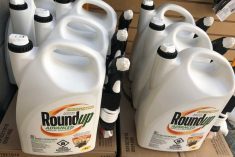A potential U.S.-China trade war has American soybean growers anxiously watching the horizon, but it looks like smooth sailing for canola markets.

“Canola is a high-quality oil that processors would use more of if they could get their hands on it. This does encourage more growth and also the increase of crush capacity we’ve seen over the last few years,” said David Reimann, a market analyst with Cargill Canada.
“It’s a highly desired oil that allows it to be a profitable crop. I think the outlook is going to remain pretty rosy.”
That’s the last word to describe the mood of oilseed growers south of the border.
In early April, U.S. President Donald Trump ordered tariffs of 25 per cent on US$50 billion worth of Chinese goods, prompting China to issue its own list of tariffs, with American soybeans high on that list. And while Trump’s tariffs are still in the ‘proposed’ stage, China isn’t waiting.
Read Also

Farming Smarter receives financial boost from Alberta government for potato research
Farming Smarter near Lethbridge got a boost to its research equipment, thanks to the Alberta government’s increase in funding for research associations.
The Communist nation, the single largest purchaser of American soybeans, essentially stopped buying after the president’s threat. Instead, China has turned to other markets (mainly Brazil and Argentina, but also Canada) and issued an “emergency notice” telling its soybean growers to plant an additional 800,000 soy acres this year.
“I don’t really see signs of the Chinese backing down,” said Marlene Boersch, owner and managing partner of Mercantile Consulting. “For example, they announced emergency measures to try to expand the Chinese soybean plantings. And also, they are clearly buying alternative origin soybeans and other grains from other countries, just in case they can’t come to an agreement with the U.S.”
Soybean prices have been rising and falling as the tariff tale takes one twist after another.
In contrast, the canola market has been rather boring.
“If I was going to summarize it, we’ve seen the market trade in a sideways range here for about the two last two, 2-1/2 months,” said Jonathon Driedger, senior analyst with Farm Link Marketing Solutions in Winnipeg. “I would describe it as having a firm undertone, but not real traction to the upside. It’s a market trying to work its way through some factors that are both on the positive bullish side and the bearish side.”
On the positive side, canola demand has been good, he said. Concerns about the dryness in Western Canada and a late spring have created a weather premium that support prices while a weaker Canadian dollar also definitely helps.
While canola is only rarely used as a substitute for soybeans, the China situation could still be a positive, said Boersch.
“Because when you crush, which is what it’s about in crush capacity in China as well, you get a lot more meal, which is what they are really after from soybeans,” she said.
Still, canola exports have lagged this year.
“On canola, we have exported to date 7.8 million tonnes, whereas last year, we had shipped 8.34 million tonnes,” Boersch said in early May. “In my mind, that’s because of a blend of the oilseed market factors — because canola was relatively expensive for a while plus some of the rail shipping problems that we have had in the 2018 year. If you look at the weekly exports, we really have been lagging last year since Christmas.”
Supply isn’t expected to be an issue this year. StatsCan surprised the market by predicting a seven per cent drop in acreage this year. But analysts widely expect the opposite — a rise of a few per cent.
“The market this year in terms of supplies is not burdensome by any stretch, but it’s not super tight,” said Driedger. It’s comfortable-ish, probably more so when you look at the new crop, as much as StatsCan came out with a number that suggests that acres are going to be lower from last year.
“I think the consensus is pretty widespread that we’re going to see an increase in seeded area. Acres are up, our supply is going to be higher and we’ll get into the new crop year. If weather is OK, we will have quite a bit of canola around.”
Some crushers were offering a bit of a premium “just to try and make sure they’ve got enough to carry them through seeding when it is harder to get it out of farmers’ bins,” he said, adding some elevators were doing the same in order to fill unit trains.
Still, this will be a year when farmers contemplating their marketing strategy will want to monitor U.S.-China relations along with the weather, he said.
“Both of those things are the real unknowns right now, but they will be the two biggest factors over the next couple of months would be my guess,” said Driedger.
American farmers are expected to seed more soybeans than corn this year (for the first time in 35 years) in hopes that crop would be a money-maker. That’s up in the air now, but canola should continue to be Prairie farmers’ Cinderella crop.
“Canola is the crop that pays the bills,” said Reimann. “In that regard, we’ve seen enough demand growth over the last couple of decades that it’s been keeping it a pretty profitable crop — even in good and bad market conditions.”















